2012 VOLKSWAGEN BEETLE tow
[x] Cancel search: towPage 92 of 268
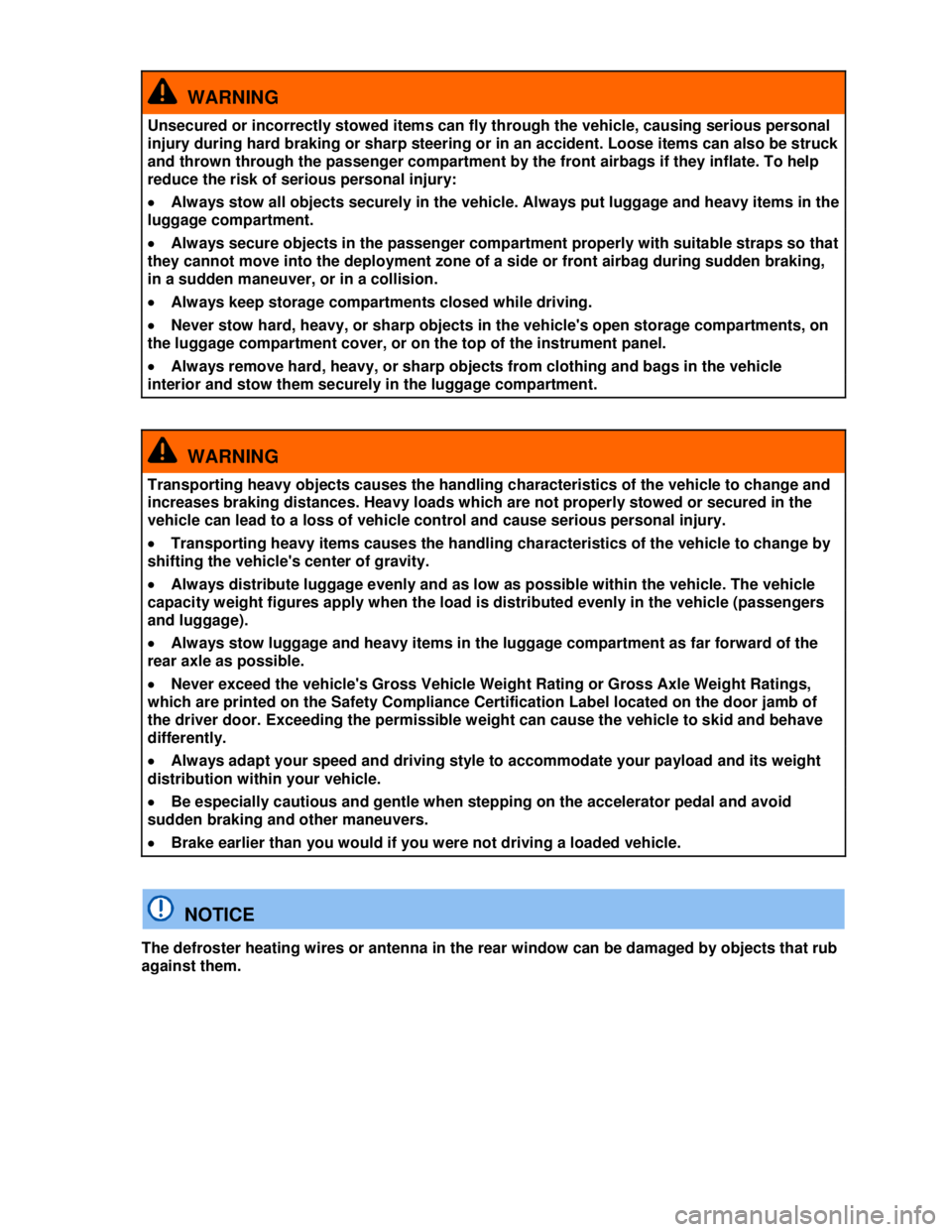
WARNING
Unsecured or incorrectly stowed items can fly through the vehicle, causing serious personal
injury during hard braking or sharp steering or in an accident. Loose items can also be struck
and thrown through the passenger compartment by the front airbags if they inflate. To help
reduce the risk of serious personal injury:
�x Always stow all objects securely in the vehicle. Always put luggage and heavy items in the
luggage compartment.
�x Always secure objects in the passenger compartment properly with suitable straps so that
they cannot move into the deployment zone of a side or front airbag during sudden braking,
in a sudden maneuver, or in a collision.
�x Always keep storage compartments closed while driving.
�x Never stow hard, heavy, or sharp objects in the vehicle's open storage compartments, on
the luggage compartment cover, or on the top of the instrument panel.
�x Always remove hard, heavy, or sharp objects from clothing and bags in the vehicle
interior and stow them securely in the luggage compartment.
WARNING
Transporting heavy objects causes the handling characteristics of the vehicle to change and
increases braking distances. Heavy loads which are not properly stowed or secured in the
vehicle can lead to a loss of vehicle control and cause serious personal injury.
�x Transporting heavy items causes the handling characteristics of the vehicle to change by
shifting the vehicle's center of gravity.
�x Always distribute luggage evenly and as low as possible within the vehicle. The vehicle
capacity weight figures apply when the load is distributed evenly in the vehicle (passengers
and luggage).
�x Always stow luggage and heavy items in the luggage compartment as far forward of the
rear axle as possible.
�x Never exceed the vehicle's Gross Vehicle Weight Rating or Gross Axle Weight Ratings,
which are printed on the Safety Compliance Certification Label located on the door jamb of
the driver door. Exceeding the permissible weight can cause the vehicle to skid and behave
differently.
�x Always adapt your speed and driving style to accommodate your payload and its weight
distribution within your vehicle.
�x Be especially cautious and gentle when stepping on the accelerator pedal and avoid
sudden braking and other maneuvers.
�x Brake earlier than you would if you were not driving a loaded vehicle.
NOTICE
The defroster heating wires or antenna in the rear window can be damaged by objects that rub
against them.
Page 99 of 268
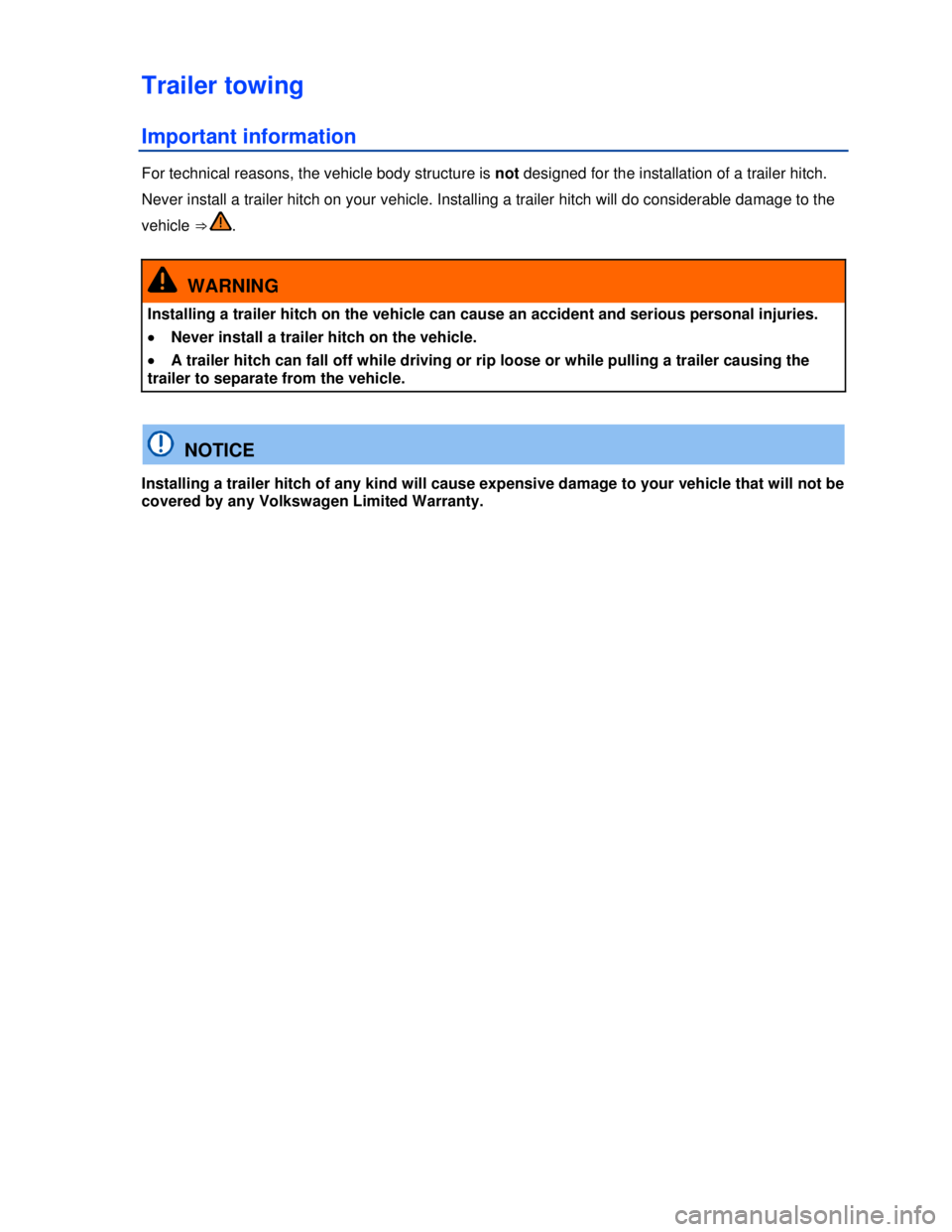
Trailer towing
Important information
For technical reasons, the vehicle body structure is not designed for the installation of a trailer hitch.
Never install a trailer hitch on your vehicle. Installing a trailer hitch will do considerable damage to the
vehicle ⇒ .
WARNING
Installing a trailer hitch on the vehicle can cause an accident and serious personal injuries.
�x Never install a trailer hitch on the vehicle.
�x A trailer hitch can fall off while driving or rip loose or while pulling a trailer causing the
trailer to separate from the vehicle.
NOTICE
Installing a trailer hitch of any kind will cause expensive damage to your vehicle that will not be
covered by any Volkswagen Limited Warranty.
Page 118 of 268
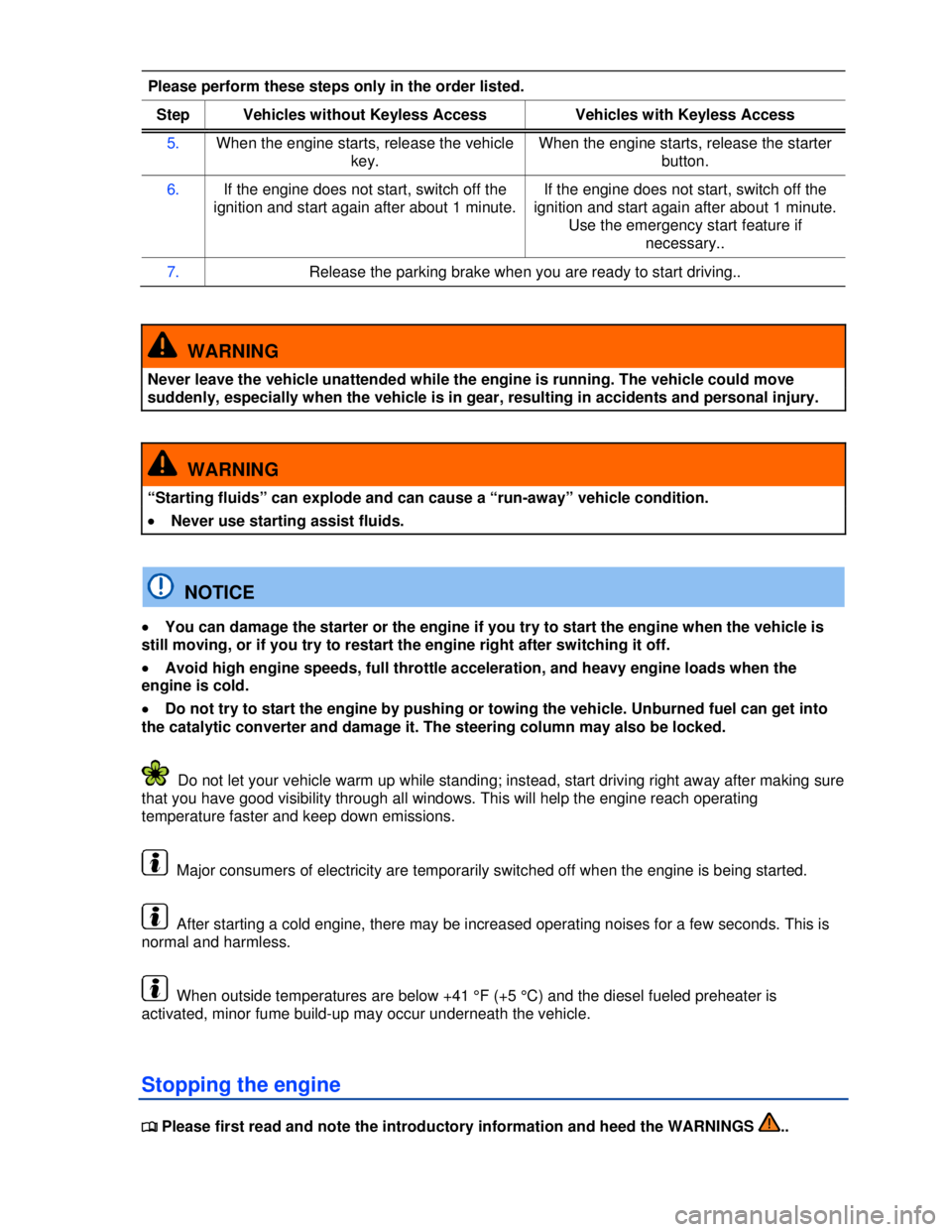
Please perform these steps only in the order listed.
Step Vehicles without Keyless AccessVehicles with Keyless Access
5. When the engine starts, release the vehicle
key.
When the engine starts, release the starter
button.
6. If the engine does not start, switch off the
ignition and start again after about 1 minute.
If the engine does not start, switch off the
ignition and start again after about 1 minute.
Use the emergency start feature if
necessary..
7. Release the parking brake when you are ready to start driving..
WARNING
Never leave the vehicle unattended while the engine is running. The vehicle could move
suddenly, especially when the vehicle is in gear, resulting in accidents and personal injury.
WARNING
“Starting fluids” can explode and can cause a “run-away” vehicle condition.
�x Never use starting assist fluids.
NOTICE
�x You can damage the starter or the engine if you try to start the engine when the vehicle is
still moving, or if you try to restart the engine right after switching it off.
�x Avoid high engine speeds, full throttle acceleration, and heavy engine loads when the
engine is cold.
�x Do not try to start the engine by pushing or towing the vehicle. Unburned fuel can get into
the catalytic converter and damage it. The steering column may also be locked.
Do not let your vehicle warm up while standing; instead, start driving right away after making sure
that you have good visibility through all windows. This will help the engine reach operating
temperature faster and keep down emissions.
Major consumers of electricity are temporarily switched off when the engine is being started.
After starting a cold engine, there may be increased operating noises for a few seconds. This is
normal and harmless.
When outside temperatures are below +41 °F (+5 °C) and the diesel fueled preheater is
activated, minor fume build-up may occur underneath the vehicle.
Stopping the engine
�
Page 128 of 268
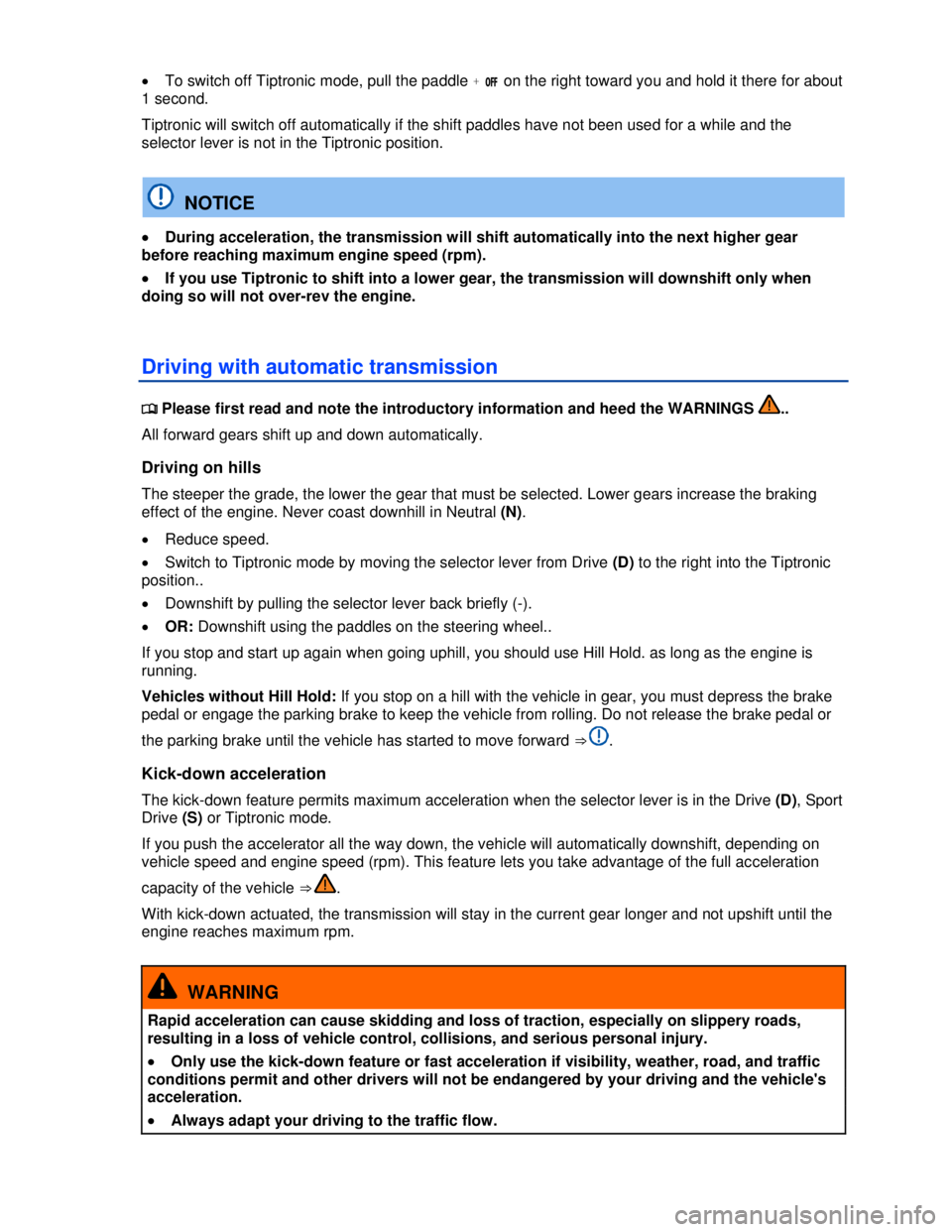
�x To switch off Tiptronic mode, pull the paddle + �/�&�& on the right toward you and hold it there for about
1 second.
Tiptronic will switch off automatically if the shift paddles have not been used for a while and the
selector lever is not in the Tiptronic position.
NOTICE
�x During acceleration, the transmission will shift automatically into the next higher gear
before reaching maximum engine speed (rpm).
�x If you use Tiptronic to shift into a lower gear, the transmission will downshift only when
doing so will not over-rev the engine.
Driving with automatic transmission
�
Page 136 of 268
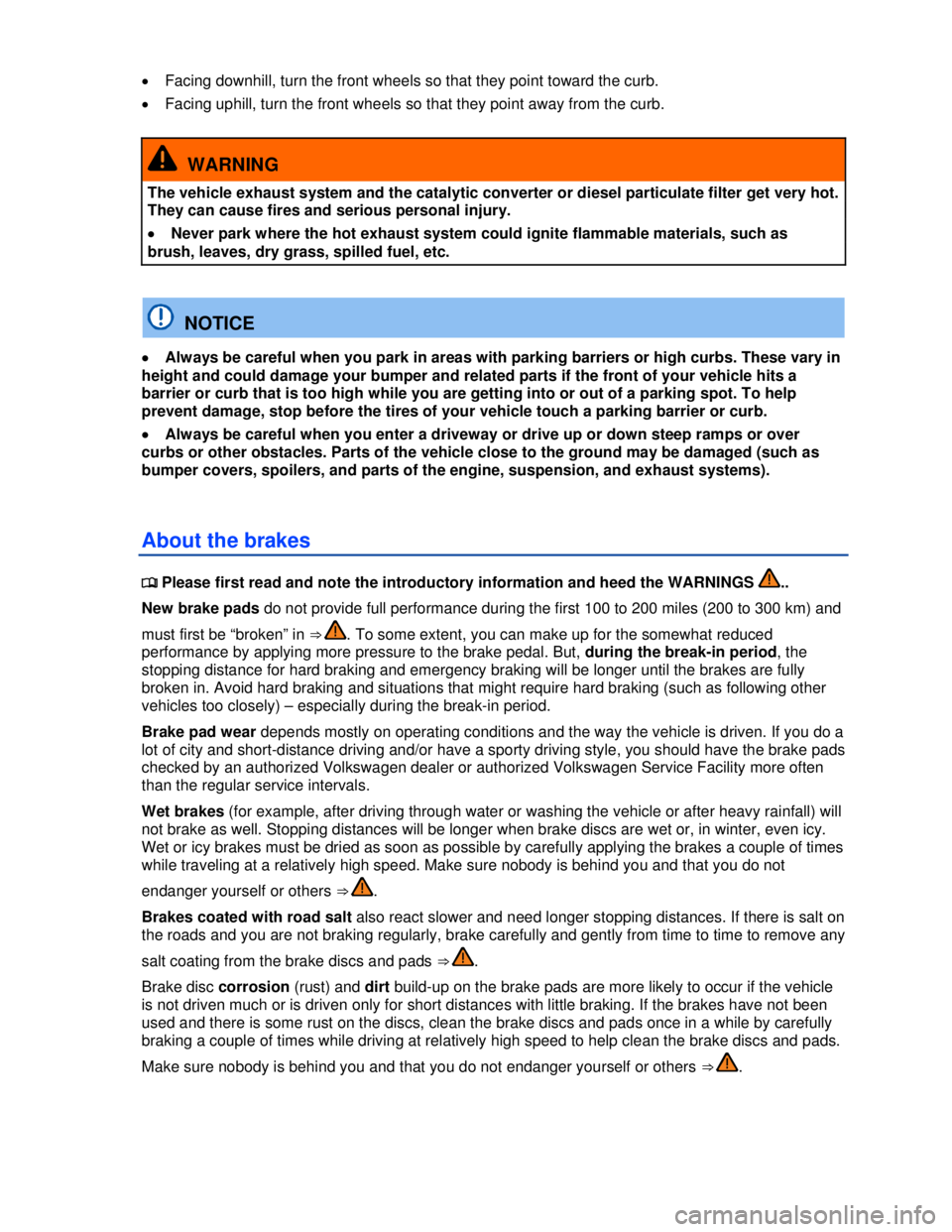
�x Facing downhill, turn the front wheels so that they point toward the curb.
�x Facing uphill, turn the front wheels so that they point away from the curb.
WARNING
The vehicle exhaust system and the catalytic converter or diesel particulate filter get very hot.
They can cause fires and serious personal injury.
�x Never park where the hot exhaust system could ignite flammable materials, such as
brush, leaves, dry grass, spilled fuel, etc.
NOTICE
�x Always be careful when you park in areas with parking barriers or high curbs. These vary in
height and could damage your bumper and related parts if the front of your vehicle hits a
barrier or curb that is too high while you are getting into or out of a parking spot. To help
prevent damage, stop before the tires of your vehicle touch a parking barrier or curb.
�x Always be careful when you enter a driveway or drive up or down steep ramps or over
curbs or other obstacles. Parts of the vehicle close to the ground may be damaged (such as
bumper covers, spoilers, and parts of the engine, suspension, and exhaust systems).
About the brakes
�
Page 137 of 268
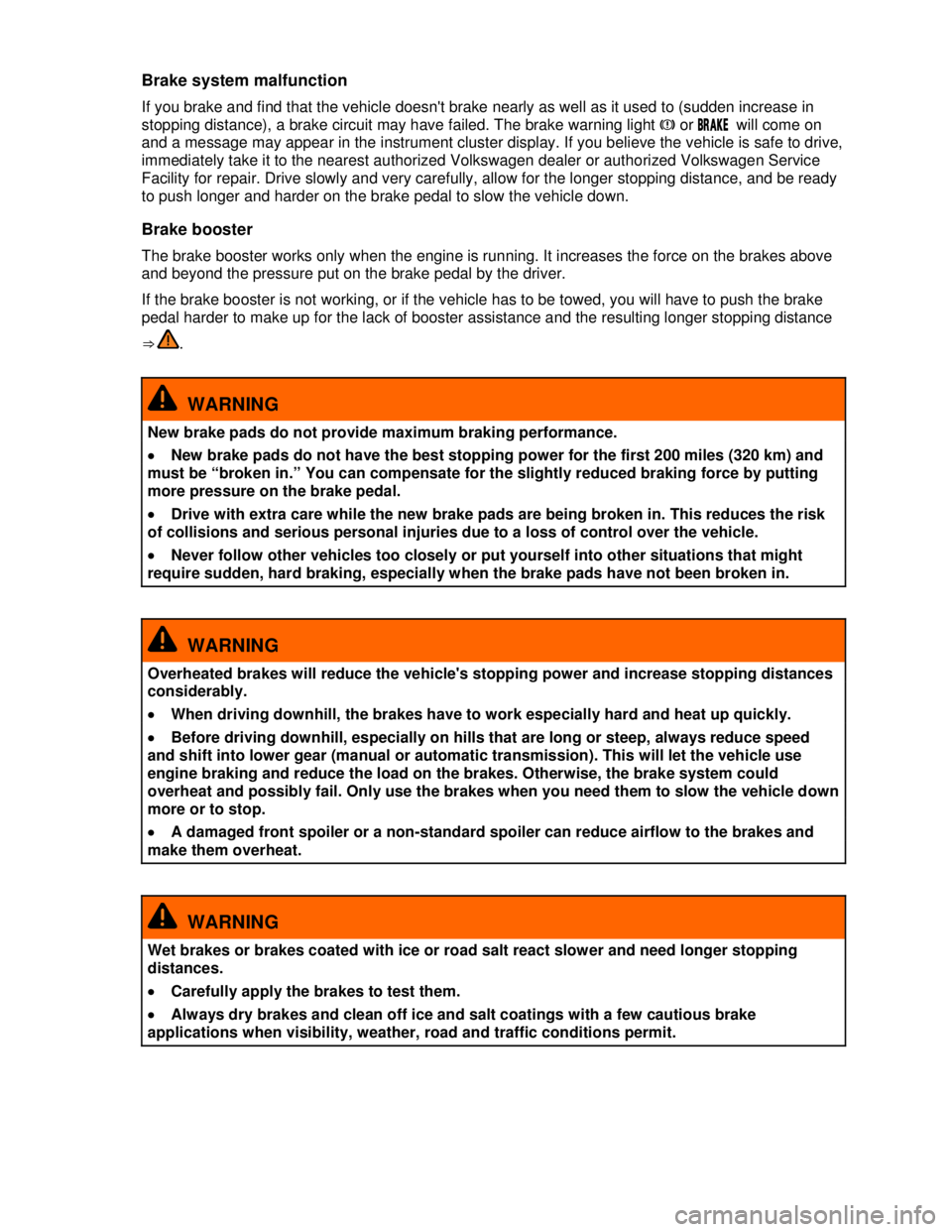
Brake system malfunction
If you brake and find that the vehicle doesn't brake nearly as well as it used to (sudden increase in
stopping distance), a brake circuit may have failed. The brake warning light �H or �"�2�!�+�% will come on
and a message may appear in the instrument cluster display. If you believe the vehicle is safe to drive,
immediately take it to the nearest authorized Volkswagen dealer or authorized Volkswagen Service
Facility for repair. Drive slowly and very carefully, allow for the longer stopping distance, and be ready
to push longer and harder on the brake pedal to slow the vehicle down.
Brake booster
The brake booster works only when the engine is running. It increases the force on the brakes above
and beyond the pressure put on the brake pedal by the driver.
If the brake booster is not working, or if the vehicle has to be towed, you will have to push the brake
pedal harder to make up for the lack of booster assistance and the resulting longer stopping distance
⇒ .
WARNING
New brake pads do not provide maximum braking performance.
�x New brake pads do not have the best stopping power for the first 200 miles (320 km) and
must be “broken in.” You can compensate for the slightly reduced braking force by putting
more pressure on the brake pedal.
�x Drive with extra care while the new brake pads are being broken in. This reduces the risk
of collisions and serious personal injuries due to a loss of control over the vehicle.
�x Never follow other vehicles too closely or put yourself into other situations that might
require sudden, hard braking, especially when the brake pads have not been broken in.
WARNING
Overheated brakes will reduce the vehicle's stopping power and increase stopping distances
considerably.
�x When driving downhill, the brakes have to work especially hard and heat up quickly.
�x Before driving downhill, especially on hills that are long or steep, always reduce speed
and shift into lower gear (manual or automatic transmission). This will let the vehicle use
engine braking and reduce the load on the brakes. Otherwise, the brake system could
overheat and possibly fail. Only use the brakes when you need them to slow the vehicle down
more or to stop.
�x A damaged front spoiler or a non-standard spoiler can reduce airflow to the brakes and
make them overheat.
WARNING
Wet brakes or brakes coated with ice or road salt react slower and need longer stopping
distances.
�x Carefully apply the brakes to test them.
�x Always dry brakes and clean off ice and salt coatings with a few cautious brake
applications when visibility, weather, road and traffic conditions permit.
Page 138 of 268

WARNING
Driving when the brake booster is not working increases stopping distances and can cause
accidents and serious personal injuries.
�x Never let the vehicle coast when the engine is switched off.
�x If the brake booster is not working (such as when the vehicle is being towed), a lot more
pedal force is needed to slow down and stop.
NOTICE
�x Never “ride” the brakes by keeping your foot on the brake pedal when you do not want to
brake. Constant pressure on the brake pedal can make the brakes overheat. Riding the brakes
will substantially reduce braking performance, increase stopping distance, and can cause
complete brake system failure.
�x Before driving downhill, especially on hills that are long or steep, always reduce speed and
shift into lower gear (manual or automatic transmission). This will let the vehicle use engine
braking and reduce the load on the brakes. Otherwise, the brake system could overheat and
possibly fail. Only use the brakes when you need them to slow the vehicle down more or to
stop.
When the front brakes are serviced, you should have the rear brake pads inspected at the same
time. The wear of all brake pads should be visually checked regularly. The best way to check for brake
pad wear is to have your authorized Volkswagen dealer or authorized Volkswagen Service Facility
visually inspect the pads through the openings in the wheel rims or from underneath the vehicle. If
necessary, the wheels can be taken off for a more thorough inspection.
Braking assistance systems
�
Page 235 of 268
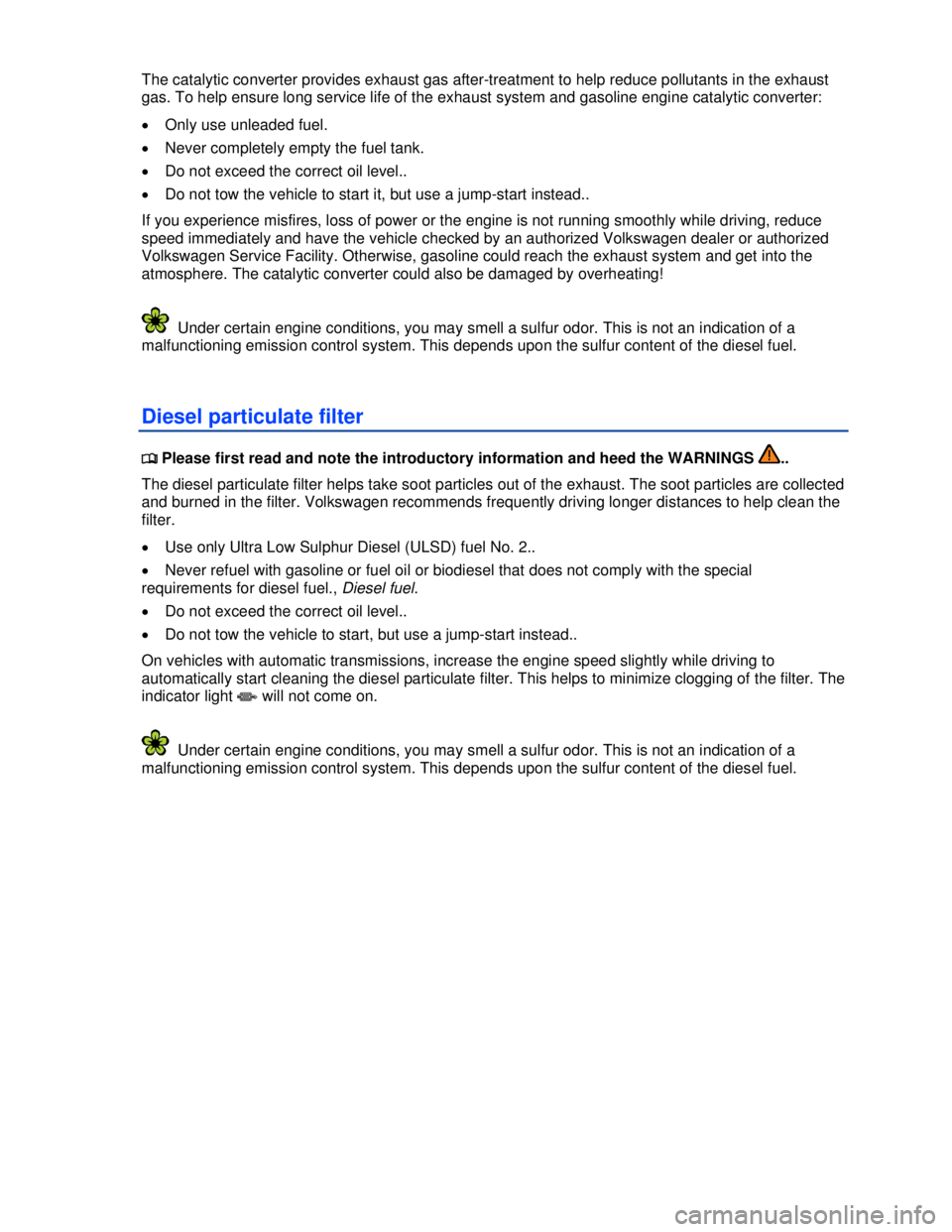
The catalytic converter provides exhaust gas after-treatment to help reduce pollutants in the exhaust
gas. To help ensure long service life of the exhaust system and gasoline engine catalytic converter:
�x Only use unleaded fuel.
�x Never completely empty the fuel tank.
�x Do not exceed the correct oil level..
�x Do not tow the vehicle to start it, but use a jump-start instead..
If you experience misfires, loss of power or the engine is not running smoothly while driving, reduce
speed immediately and have the vehicle checked by an authorized Volkswagen dealer or authorized
Volkswagen Service Facility. Otherwise, gasoline could reach the exhaust system and get into the
atmosphere. The catalytic converter could also be damaged by overheating!
Under certain engine conditions, you may smell a sulfur odor. This is not an indication of a
malfunctioning emission control system. This depends upon the sulfur content of the diesel fuel.
Diesel particulate filter
�